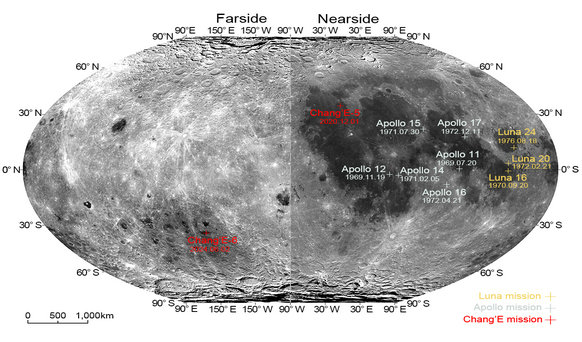Chinese Scientists analyze first lunar farside samples collected from the other half of the Moon

The Topographic Map illustrates the landing sites of the Chang’E Missions, Apollo Missions, and Luna Missions. (Image by NAOC)
A Chinese team of scientists has undertaken a study of lunar samples retrieved by the Chang’E-6 mission. These are the first samples studied from the farside of the Moon. They mark a significant milestone in lunar exploration science and technical exploration capability.
Their research is published in the journal National Science Review on September 17, 2024.
“As the first lunar sample obtained from the far side of the Moon, the Chang’E-6 sample will provide an unparalleled opportunity for lunar research,” said Prof. Chunlai Li, National Astronomical Observatories, Chinese Academy of Sciences. This unique sample helpsto advance the understanding of several key aspects of lunar science, including the Moon’s early evolution; the variability of volcanic activities between the nearside and farside; the impact history of the inner solar system; the record of galactic activity preserved in the lunar weathering layer; the lunar magnetic field and its anomalies and duration; and the composition and structure of the lunar crust and mantle. “These insights are expected to lead to new concepts and theories regarding the origin and evolution of the Moon, and refine its use as an interpretive paradigm for the evolution of the terrestrial planets,” said Li.
Adding together the lunar samples gathered from the six Apollo missions, three Luna missions, and the Chang’E-5 mission, scientists have collected a total of 382.9812 kg of lunar samples. These lunar samples have provided scientists with critical information on the formation and evolutionary history of the Moon. “Returned lunar samples are essential to planetary science research, as they provide key laboratory data to link orbital remote sensing observations to actual surface ground truth,” said Li. The samples have contributed to the development of hypotheses, such as the Moon’s giant impact into early Earth origin, the Lunar Magma Ocean, and the Late Heavy Bombardment. These earlier studies of lunar samples, all of them collected from the lunar nearside, have significantly advanced the discipline of planetary science. From a sampling perspective, the farside has remained unexplored until now.
“Nearside samples alone, without adequate sampling from the entire lunar surface, especially from the farside, cannot fully capture the geologic diversity of the entire Moon. This limitation hampers our understanding of the Moon’s origin and evolution,” said Li. Scientists gained the much-needed farside lunar samples when the Chang’E-6 mission collected 1935.3 grams of lunar samples from the South Pole-Aitken basin on June 25, 2024.
The samples were gathered from the lunar surface using drilling and scooping techniques. The team analyzed the samples’ physical, mineralogical, petrographic, and geochemical properties. Their analysis showed that the collected samples reflect a mixture of “local” basaltic material and “foreign” non-mare material. The rock fragments in the CE-6 samples are mainly basalt, breccia, and agglutinates. The primary constituent minerals of the soils are plagioclase, pyroxene, and ilmenite, with very low olivine abundance. The lunar soil in the Chang’E-6 samples is mostly a mixture of local basalts and non-basaltic ejecta materials.
The lunar surfaceis divided into three very distinct geochemical provinces based on variations in geochemical characterization and petrologic evolutionary history. These are the Procellarum KREEP Terrane (PKT), the Feldspathic Highland Terrane (FHT), and the South Pole-Aitken Terrane(SPAT).
“These local mare basalts document the volcanic history of lunar farside, while the non-basaltic fragments may offer critical insights into the lunar highland crust, South Pole-Aitken impact melts, and potentially the deep lunar mantle, making these samples highly significant for scientific research,” said Li.
The lunar samples collected from the nearside by the Apollo, Luna, and CE-5 missions included samples from the PKT and the FHT. Until now, no samples had been collected from the unique SPAT on the lunar farside. Scientists believe the South Pole-Aitken basin was formed 4.2 to 4.3 billion years ago in the Pre-Nectarian period. It is the largest confirmed impact basin in the Solar System.
The research is funded by the Key Research Program of the Chinese Academy of Sciences.
The research team includes: Chunlai Li, Jianjun Liu, Qin Zhou, Xin Ren, Bin Liu, Dawei Liu, Xingguo Zeng, Wei Zuo, Guangliang Zhang, Hongbo Zhang, Saihong Yang, Xingye Gao, Yan Su, and Weibin Wen, from the National Astronomical Observatories, Chinese Academy of Sciences, Beijing;Hao Hu and Qiong Wang from the Lunar Exploration and Space Engineering Center, Beijing; Meng-Fei Yang and Xiangjin Deng from the Beijing Institute of Spacecraft System Engineering, Beijing; and Ziyuan Ouyang from the National Astronomical Observatories, Chinese Academy of Sciences, Beijing, and also the Institute of Geochemistry, Chinese Academy of Sciences, Guiyang.
The paper can be accessed at https://doi.org/10.1093/nsr/nwae328